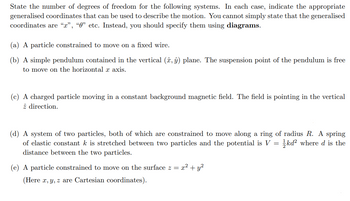State the number of degrees of freedom for the following systems. In each case, indicate the appropriate generalised coordinates that can be used to describe the motion. You cannot simply state that the generalised coordinates are "x", "0" etc. Instead, you should specify them using diagrams. (a) A particle constrained to move on a fixed wire. (b) A simple pendulum contained in the vertical (x, y) plane. The suspension point of the pendulum is free to move on the horizontal x axis. (c) A charged particle moving in a constant background magnetic field. The field is pointing in the vertical 2 direction. (d) A system of two particles, both of which are constrained to move along a ring of radius R. A spring of elastic constant k is stretched between two particles and the potential is V = kd² where d is the distance between the two particles. (e) A particle constrained to move on the surface z = x² + y² (Here x, y, z are Cartesian coordinates).
State the number of degrees of freedom for the following systems. In each case, indicate the appropriate generalised coordinates that can be used to describe the motion. You cannot simply state that the generalised coordinates are "x", "0" etc. Instead, you should specify them using diagrams. (a) A particle constrained to move on a fixed wire. (b) A simple pendulum contained in the vertical (x, y) plane. The suspension point of the pendulum is free to move on the horizontal x axis. (c) A charged particle moving in a constant background magnetic field. The field is pointing in the vertical 2 direction. (d) A system of two particles, both of which are constrained to move along a ring of radius R. A spring of elastic constant k is stretched between two particles and the potential is V = kd² where d is the distance between the two particles. (e) A particle constrained to move on the surface z = x² + y² (Here x, y, z are Cartesian coordinates).
Oh no! Our experts couldn't answer your question.
Don't worry! We won't leave you hanging. Plus, we're giving you back one question for the inconvenience.
Submit your question and receive a step-by-step explanation from our experts in as fast as 30 minutes.
You have no more questions left.
Message from our expert:
Our experts are unable to provide you with a solution at this time. Try rewording your question, and make sure to submit one question at a time. A question credit has been added to your account for future use.
Your Question:

Transcribed Image Text:State the number of degrees of freedom for the following systems. In each case, indicate the appropriate
generalised coordinates that can be used to describe the motion. You cannot simply state that the generalised
coordinates are "x", "0" etc. Instead, you should specify them using diagrams.
(a) A particle constrained to move on a fixed wire.
(b) A simple pendulum contained in the vertical (x, y) plane. The suspension point of the pendulum is free
to move on the horizontal x axis.
(c) A charged particle moving in a constant background magnetic field. The field is pointing in the vertical
2 direction.
(d) A system of two particles, both of which are constrained to move along a ring of radius R. A spring
of elastic constant k is stretched between two particles and the potential is V = kd² where d is the
distance between the two particles.
(e) A particle constrained to move on the surface z = x² + y²
(Here x, y, z are Cartesian coordinates).
